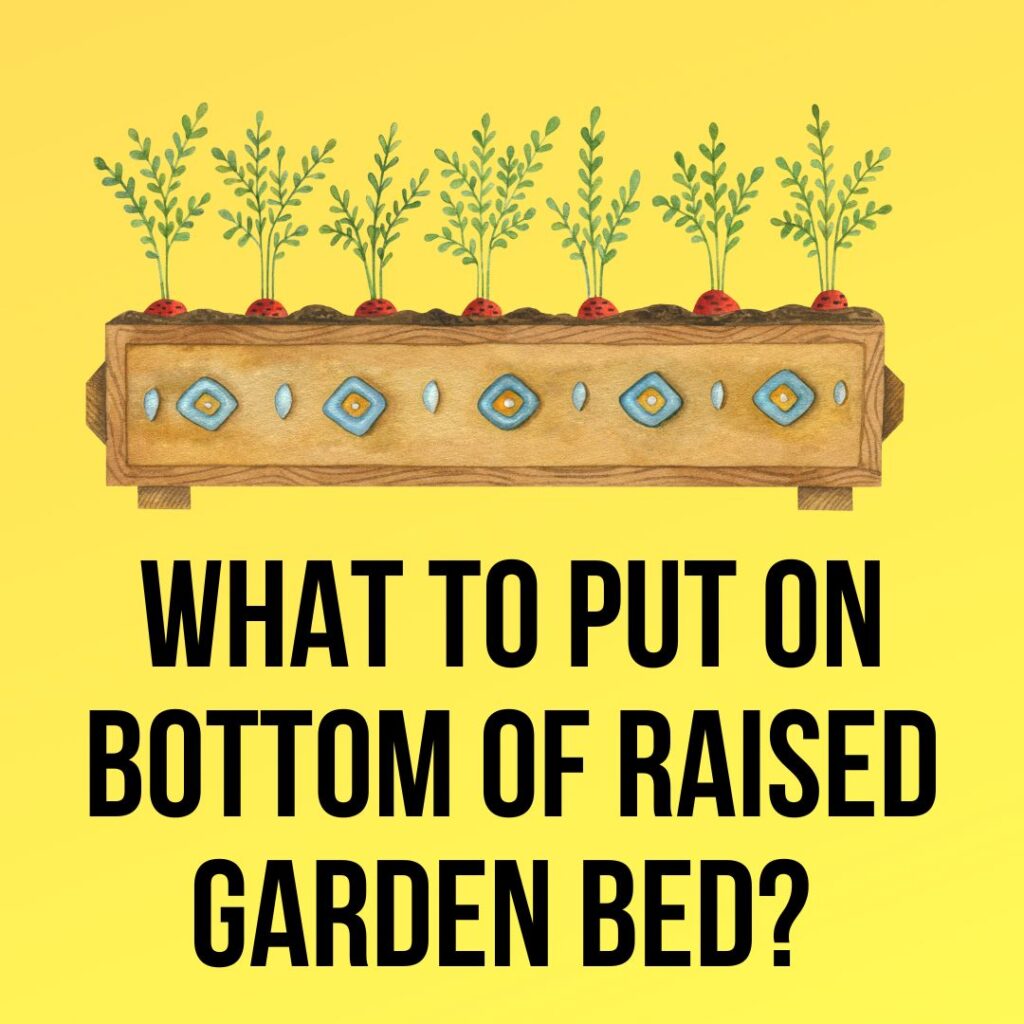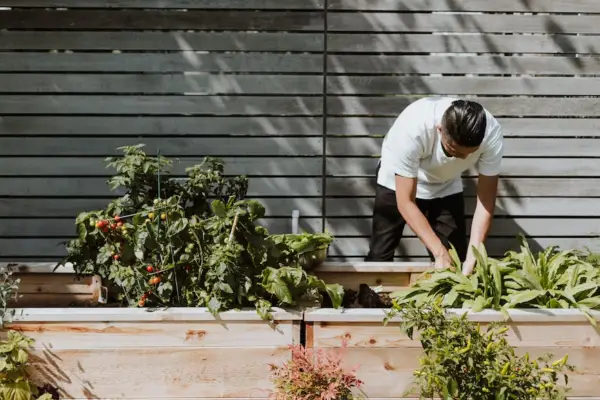There’s a solid reason why gardening on raised beds has become more popular: they’re really effective. For a low-maintenance garden in nearly any location, raised beds are the way to go. They allow for better drainage and aeration of the soil, and they shield plants from weeds and pests. The aesthetic value of these lush, full mattresses is incidental.
Growing a garden on raised beds, as opposed to planting directly in the ground, may provide a number of benefits. When you use raised beds, weeds are kept to a minimum, and you have more say over the kind of soil your plants are grown in, which are two of the most significant advantages of this gardening method. However, beginning with raised beds often results in plenty of inquiries. The question “What to place at the bottom of raised garden beds?” is one of the most often asked queries.
What therefore should one place at the base of a raised garden bed? A barrier between the soil in your garden and the ground below should ideally be built at the bottom of a raised garden bed in order to assist in preventing weeds from growing there. Cardboard, newspapers, leaves, and landscape fabric are all examples of materials that are often used for barriers; however, there are many additional possibilities available as well.

What To Put On Bottom Of Raised Garden Bed?
There is an almost infinite variety of materials that you may use as a barrier for your garden bed; however, each one comes with its own set of advantages and disadvantages.
This article will discuss the numerous materials that gardeners use at the bottom of their raised beds, as well as the benefits and downsides of each, so that you may choose which one is the most suitable for your specific needs and circumstances.
Here in this article, you will get to know about six types of materials that are useful for filling up the bottom of your raised garden bed. So, let’s get to it!

1. Newspaper
When it comes to selecting material to place at the bottom of your raised bed, the newspaper is an excellent choice since it is both inexpensive and readily available. The bottom of your garden bed may be prepared for planting by laying down some old newspapers, followed by the addition of soil, and then you are good to go! You now have a barrier that will prevent weeds from growing.
Even though the newspaper is resistant to degradation, it will gradually crumble into smaller and smaller pieces if given enough time. Even though your barrier will be demolished, it will still cause a significant amount of carbon to be released into the earth. This is a positive thing since carbon helps feed the bacteria that live in the soil, which ultimately results in the soil in a garden being better and healthier.
Because of the ink that is on the newspaper, many people are concerned that it may pollute the ground with harmful chemicals and pollutants. This is because of the ink that is on the newspaper. The ink used in newspapers, on the other hand, is made from soy, and as a result, it poses no threat to either the plants growing in the soil or the soil itself.
2. Cardboard
If you’re working with a limited budget, cardboard is another inexpensive yet effective material to use for the base of a raised bed. Along the same lines as newspapers, not only is it extremely inexpensive but it is also quite simple to get.
In the long run, the cardboard will break down into its component parts, although this process will be considerably slower than that of newspaper due to cardboard’s greater density and durability. The average time it takes for cardboard to degrade is between four and six months; however, the kind of cardboard that is used has a significant influence on how quickly it decomposes.
Although you may use almost any kind of cardboard to line the bottom of your raised bed, you can anticipate that the sheets of cardboard that are thicker and have more layers will perform the best. They are able to withstand decomposition for far longer because of their durable corrugated structure, in comparison to cardboard which is just one layer thick.
However, you should stay away from utilizing cardboard that has glossy print on it since it might be difficult to cut. Products like cereal boxes, soda boxes, and shoe boxes are included in this category, although it’s not exclusive to those things. When this particular kind of cardboard breaks down, the glossy ink on it has the potential to release chemicals and pollutants into the soil. This, in turn, will be detrimental to the soil and plants in the surrounding area.
3. Fabric for Gardening/ Landscape Fabric
Landscape fabric, if you can afford it, is a fantastic material for the base of a raised bed.
Landscape fabric has a long lifespan and doesn’t break down easily, which is a major benefit. Toss out that old landscape fabric? It won’t need to be changed for at least ten more. That’s why it’s such a good choice for the future.
Your raised bed might have landscape fabric on both the bottom and the top of the soil. Make sure you leave gaps for your plants to grow through. To prevent weeds from growing in your raised bed, lay landscaping fabric over the bottom and up the sides.
Because of its permeable nature, landscape fabric may be used without fear of water imperviousness. Water will easily permeate the cloth if you just sprinkle it with water.
4. Burlap
If you’re looking for an alternative to landscape fabric, burlap is a fantastic choice. In comparison to landscape fabric, its lifespan is shorter, but it still has a long way to go until it biodegrades.
Water easily permeates burlap because of the spaces between the threads. Consequently, using burlap will improve the drainage in your raised bed.
Burlap’s eco-friendliness is a further advantage. These plants need almost little effort to cultivate, but they remove many times as much carbon dioxide from the air and generate many times as much oxygen as trees do.
But the edges of burlap tend to fray quite quickly, so that’s one negative to utilizing it. After being chopped, torn, or even simply left out in the weather for a while, the edges of burlap begin to fray and unravel. If you do this, not only will your burlap start to break down faster, but it will also appear worse.
5. Leaves
In the event that you do not have access to any of the materials described above, you may use leaves to line the bottom of your raised bed, which will assist in preventing weed growth for a certain amount of time.
Even if it isn’t too difficult to stuff leaves down into the base of a raised bed, sooner or later those leaves are going to break down and become compost. The decomposition of leaves normally takes between six and twelve months. On the plus side, after those leaves have been composted, your soil will have a significant increase in the amount of organic matter it contains.
Before beginning to add soil to your raised bed, collecting as many leaves as you can possibly manage to collect might be one strategy for slowing down the rate at which leaves decompose. The process of decomposition may be greatly slowed down when organic matter such as leaves get matted together and clumped together. Therefore, the longevity of your barrier will be directly proportional to the amount of leave that you load into the base of your raised bed.
6. Stones
If you don’t have many other alternatives left, stones, rocks, or even pebbles are all viable choices for the material you use. Rocks, in contrast to the other possibilities on this list, will not deteriorate (at least not during your lifetime), thus they may serve as a barrier that is in place indefinitely. This makes this particular choice an unusual one.
There are a number of difficulties associated with utilizing stones and rocks as a barrier for your raised bed that many people would consider to be not worth it. These drawbacks include the fact that stones and rocks are practically hard to decompose.
The first disadvantage of using boulders as a barrier is that quite a few of them are required in order to completely cover the base of your raised bed in their entirety. In spite of the fact that there are undoubtedly going to be a few stones laying somewhere on your land, it is quite unlikely that you will have enough to construct a complete barrier for the floor of your raised bed. As a direct consequence of this, you may have to search in more locations for more stones.
Even if you have a sufficient number of stones to construct your raised bed, there is a good chance that the spaces in between the stones are large enough to allow weeds to grow through them. The use of smaller stones, which will ultimately result in fewer gaps, is one strategy you may use to deal with this issue.

Overview
Besides all these items, you can also use Wood, Hardware fabrics for the lining. Plastic is not recommended for lining though if you want you can use them in your veggie garden but you have to make sure you make holes in that.
Conclusion
You need to have some thoughts at this point about the materials to use for the base of your raised garden bed. There is a wide variety of choices available, each of which comes with its own set of advantages and disadvantages; nevertheless, it is up to you to pick which option is the most suitable for you. In spite of this, growing in raised beds, as opposed to planting directly in the ground, will almost always provide a greater number of benefits, regardless of which method you decide to use.
